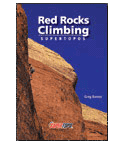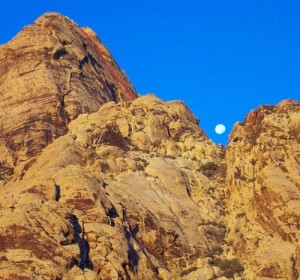Chuckwalla, Global Peak 5.9 |
||
Red Rocks, Nevada USA | ||
| ||
|
Avg time to climb route: 4-6 hours
Approach time: 3 hours Descent time: 3-4 hours Number of pitches: 6 Height of route: 800' Overview
Chuckwalla is guarded by a long approach yet is an awesome face route in the middle of beautiful and unique surroundings. The climbing is continuous, stiff, and runout by Red Rocks standards; it can be compared to well-protected face climbs in Tuolumne. Chuckwalla is intimidating, striking a nearly perfect straight line up a monolithic blank wall. With its newly replaced bolts and a rack requiring little pro other than nuts, it’s a stellar backcountry adventure.
Photos
- View all 1 photos of Chuckwalla as: Thumbnails | Slideshow
Climber Beta on Chuckwalla
Which SuperTopo guidebooks include a topo for Chuckwalla?
Find other routes like
Chuckwalla
History
This route was originally called Chuckawalla 21 because there were 21 bolts and “chuckawalla” was the phonetic pronunciation of a local lizard. Two bolts have been added, and the spelling corrected, hence the name, Chuckwalla.George and Joanne Urioste initially spotted the formation while descending from the Velvet Wall, one canyon north. Joanne gave it the name Global Peak because, “Well, it was round.” Impressed with the route potential, they worked their way back into the canyon in May 1978. They climbed the nearby route, Sidewinder, which was, of course, named after another desert creature. But the Uriostes were mainly attracted to the line of Chuckwalla, even though it would require bolt protection on some blank face climbing sections. They made plans to return and work on the new route. Meanwhile, Joe Herbst also had his eye on the formation, which he intended to name “The Spirit Kiln.” He picked out a line and was planning to scout it, but had not yet gotten around to checking it out. The area was so remote that he felt no rush. In fact, he felt mild pride at simply having spotted the route potential in this inaccessible canyon. He was taken by surprise when the Uriostes invited him to come along on the Chuckwalla first ascent. Although Joe’s initial reaction was a disappointed, “Doggone!” he was impressed with the Uriostes’ line, which he considered better than his own idea. Beyond that, it brought him to the realization that George and Joanne had the ability and willingness to put up excellent new routes. The route went well. Even though Joe viewed bolts with skepticism, he could not help but be impressed that George placed all 21, drilling by hand, in one day. On the descent, they passed a small tower, the top of which was composed of several precariously stacked blocks. Observing the potential danger to future parties, Joe suggested that they kick down the loose top layer. Unfortunately, this was a suggestion he made AFTER rappelling past it. He believed he was safely off to the side when George dislodged the threatening debris. A large block took a freak bounce and came straight toward him. “It was really close,” he said. “It was like playing dodgeball, except you could die. I was pretty shaken up.” – Larry DeAngelo Strategy
Start very early, especially on shorter days. Most people can expect to start and end the day with headlamps. With its northern exposure and the great swimming holes half way up the approach, this could be a fun warm weather climb if you get an early enough start to avoid the worst of the desert heat.The first pitch is the psychological crux for most. It has substantial runouts and tricky pro. The second pitch has a runout off the belay, and a section of slopey holds which come as a surprise after relying on good edges, but it is the continuous nature of this long pitch which forms the crux. The fourth pitch is continuous, and protection in the crack sometimes spotty, so it’s wise to stop for good placements whenever possible. This is a long pitch, and it’s easy to run out of draws for clipping nuts. Use long slings to avoid rope drag. The fifth pitch is “only 5.5” but very run out on loose holds. Obviously a route with a 3 hour approach is a poor choice for bad weather; no bivi permits are available for this canyon. Retreat
Rappel with two ropes from any pitch, and retrace the approach.Approach
The approach is long with a lot of bushwacking and routefinding. It takes most people at least 3 hours. Park at the Black Velvet Canyon (BVC) parking lot. Hike up the old road/mountain bike trail toward BVC for a few hundred yards, but when the BVC trail takes off right, follow the winding bike trail left for about 0.5 mile to a large triangular boulder (“Matterhorn Boulder”). From here, the bike trail heads south, but hike southwest toward the mouth of Mud Spring Canyon and a huge brown boulder (don’t get too high, stay in the easy flats). From the giant brown boulder, head up into the canyon following burro trails to the right of the canyon bottom—again, don’t go too high, but follow the main burro trail. Hike up the canyon for about a half mile—you will get closer to a red rock band on the right (Chinle formation, like the junky stuff below Frogland). Near the end of the rock band is the first place it looks possible to cut up—go up here, following a few large old cairns. There is a small roof on the top of a 300-foot brown rock formation above this point (“the Turtle Head”); it’s easy to spot even in the dark on the way down since the roof cuts against the neon-lit skyline. Cut right above the red rock band for a bit to get to a large ramp which heads up and left at the base of the Turtle Head formation. There are some boulder problem/bushwacking approach difficulties here. Follow the ramp up and around the corner to a spectacular view of the North branch of Mud Spring Canyon, and your first fairly good view of Global Peak. Contour down and right on a ledge system, passing through a short “narrows” slot, to the canyon bottom above some killer swimming pools. From here, a long section up the main canyon bottom gets you to a bushy ramp to the left. In this canyon you encounter boulder-hopping, bushwacking, and a few 5th class sections (see next paragraph), the last of which has a rap anchor off a tree. Follow this bushy ramp up a few hundred yards past some tricky spots to the base of the sheer wall. Chuckwalla heads up the blank face to the left of the obvious corner system (Sidewinder), and starts above a low-angle ramp, going up a 30-foot-tall flake, then left and back right past three bolts to an anchor at a break in angle on the face. The first “5th class section” in the canyon bottom is easy with only a 20-foot chimney/corner that is probably more like 4th class—it’s easy to hand up packs. The second (with the rap anchor) is a two-step waterfall/giant boulder blockage, about 40 feet high. At the first step you face climb 15 feet up on the left wall about 30 feet before the overhung boulder, then step onto a ledge and walk to the start of the second tier. The face is difficult with a pack, but without, there’s a nice finger lock that is not too scary; you can haul packs once you’re up. The second tier is a surprisingly slippery chimney up the right side of the big boulder—a good spotter is all you really need—then haul the packs up with a rope, and fix the line to the rap anchor for your partner(s) to grab (or you could set up a belay). Descent
Rappel and reverse the approach. The raps will take 30-45 minutes, and the descent is not much faster than the approach. Remember to leave your harnesses on and keep a rope on top of your pack for the rappel past the 40-foot 5th class section.
Everything You Need to Know About
Red Rocks
Search the internet for beta on
Chuckwalla
|
|


